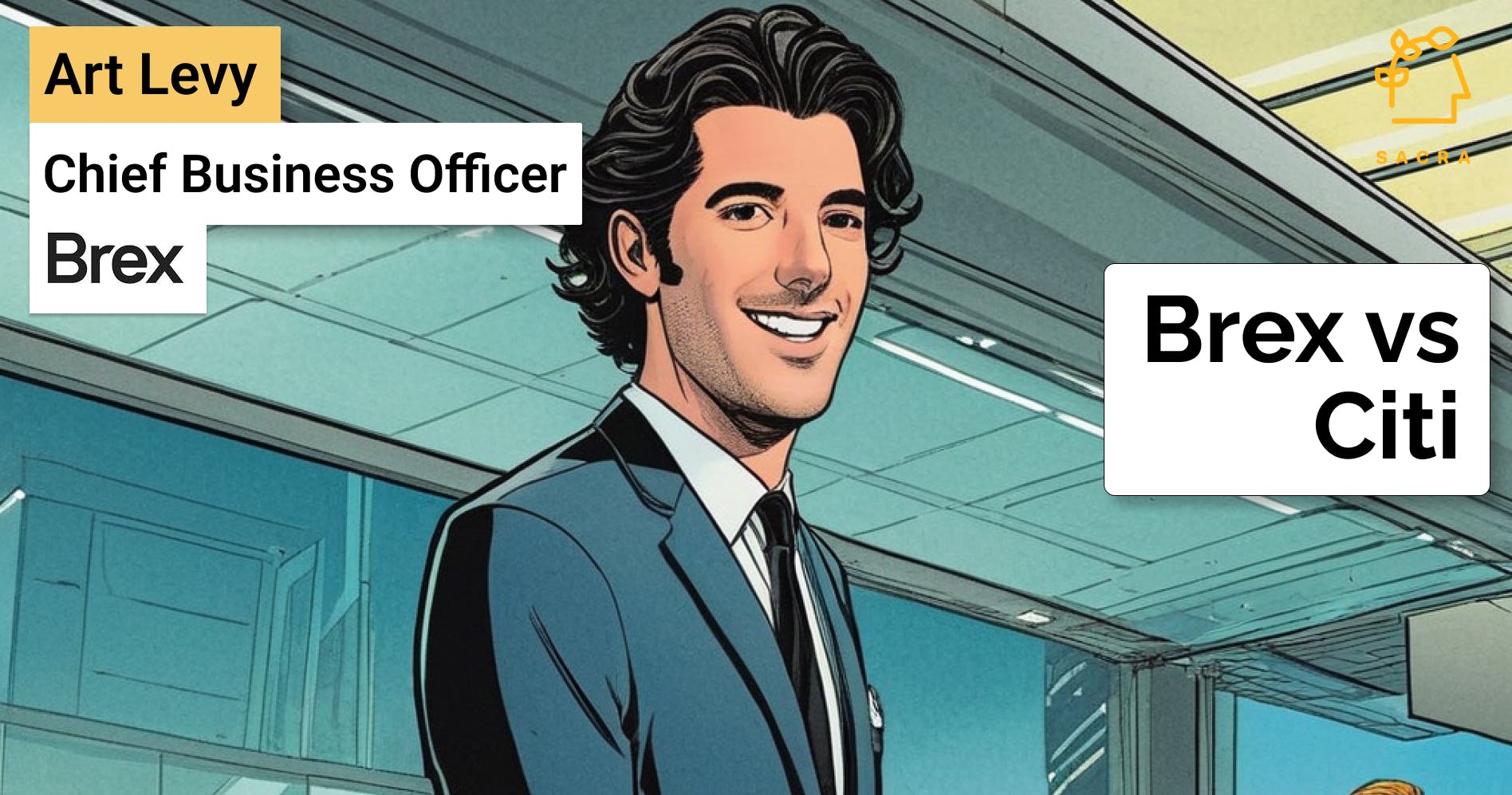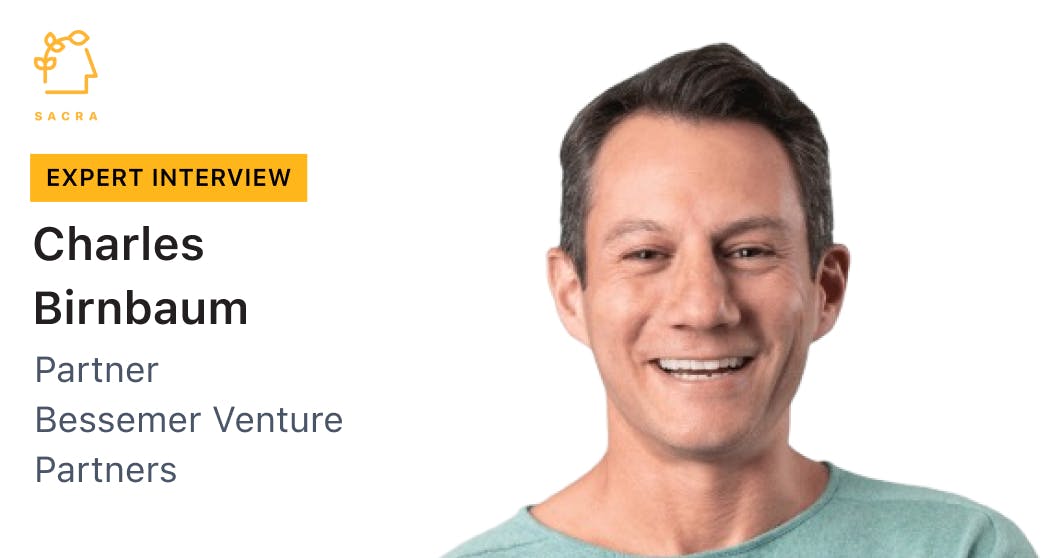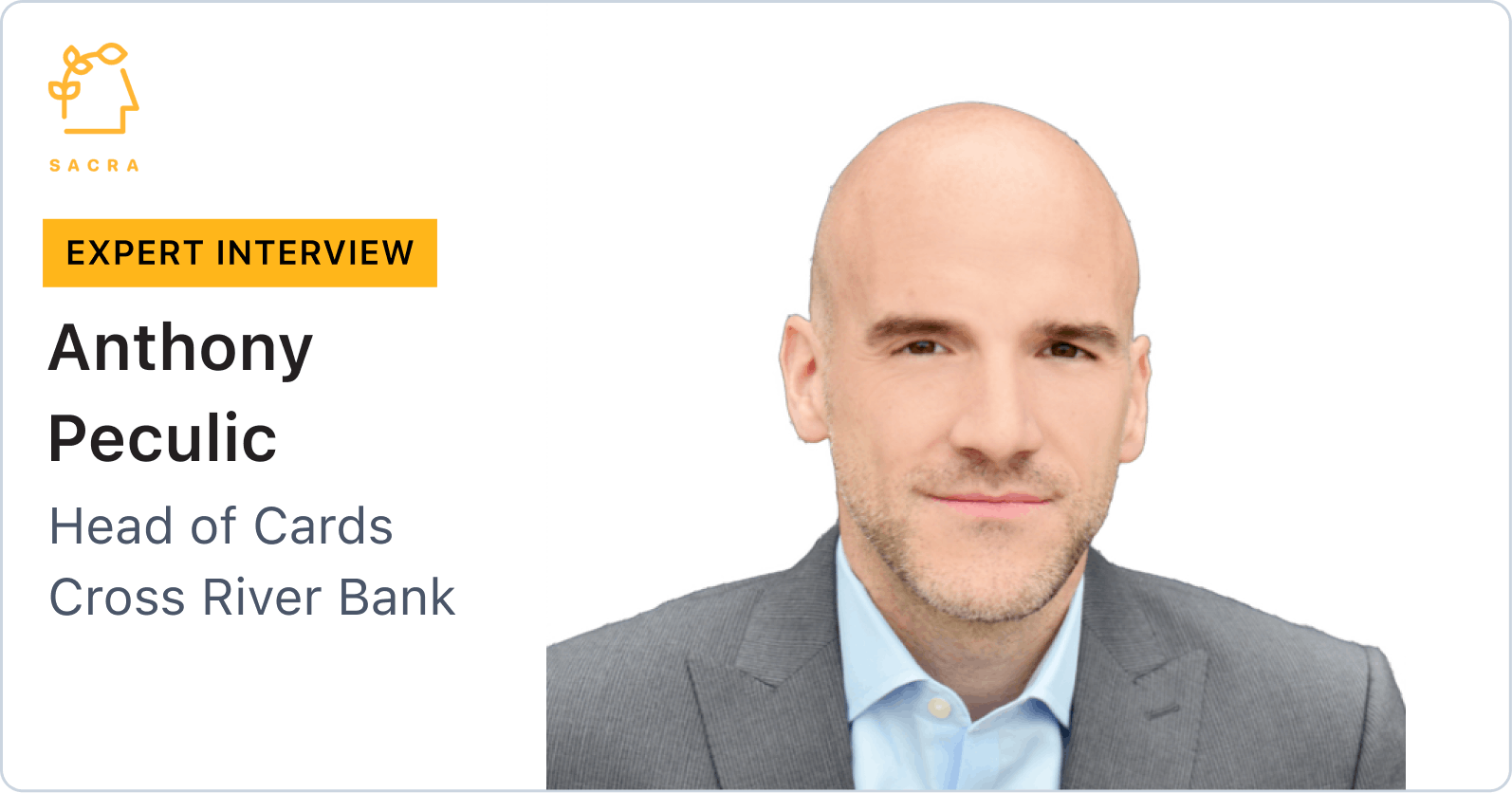The future of interchange
 Jan-Erik Asplund
Jan-Erik Asplund

Early fintechs like Chime scaled to $100M+ with nearly all their revenue coming from interchange—the fee they generate every time their customers use their cards to make purchases.
Today, we’re increasingly seeing fintechs diversifying, moving towards alternate models of monetization like subscriptions, interest from deposits and lending, and tips.
To learn more, we teamed up with Sandhill Markets on a panel conversation on the future of interchange with Nikil Konduru, head of expansion at Lithic, and Matt Brown, partner at Matrix Partners.
Three key takeaways from the conversation:
- The fintech industry is seeing a trend of consolidation, with larger platforms acquiring smaller fintechs to leverage established customer bases and cross-sell financial products. Lithic’s head of expansion Nikil Konduru said, "These larger platforms have established customer bases, so they've already figured out distribution. Now they're reselling and cross-selling to those existing customers, which has always been one of the harder things for new fintechs to do."
- Real-time payments (RTP) may not significantly threaten card networks for consumer-to-business transactions but could revolutionize disbursements and payroll processes. "When you think about payroll, for example, it could be attractive if a provider says, 'Hey, the second you finish your shift, money's going to land in your account. You don't have to wait and get paid every two weeks,'" Nikil Konduru said.
- Restricted spend categories, such as government benefits (EBT, SNAP) and healthcare spending accounts (HSA, FSA), represent a significant opportunity for fintech innovation due to their large transaction volumes and specific regulatory requirements. Matrix partner Matt Brown said, "Unlocking these broader restricted categories for online or more digital transactions is pretty interesting, especially as they involve such large amounts of money."
Transcript:
Adam: How are we doing? Matt, can you introduce yourself?
Matt: Absolutely. I'll start with Matrix briefly. We're an early-stage venture firm that has been in business for close to 50 years, making us one of the older, more tenured venture firms in the US. We've been pretty consistent across the decades in how we invest.
Firstly, we focus on early-stage only, from concept to Series A. We don't do late-stage investing, don't have a hedge fund, and don't do growth investing. We typically work with founders at the whiteboard stage all the way up to their first real institutional round of capital.
Secondly, and this relates to the Interchange topic a bit, we're generalists as a firm, but individual investors are specialists. TJ, as you mentioned, focuses on healthcare. Other folks focus on semiconductors or B2B SaaS. I focus solely on fintech. That's where my background is, that's what I know, that's what I stay up late at night reading about when I should probably be going to bed. It's just what's interesting and exciting to me.
Lastly, we're a very small team of 10 investors. Everyone's a former founder who has built, scaled, and sold companies. We're very hands-on with the companies we invest in and work with. This approach ties back to our focus on what we know and doing a small number of investments. When we invest in a payments company, it's not because we read some report or McKinsey publication that payments are the future, but because we've seen these trends in our own past experiences.
As for my background, like many folks here, I started two Matrix-backed companies before joining the firm. The second one, called Bonsai, started as a vertical software company and eventually added payments acceptance and card issuing. Being able to monetize not just SaaS but all these other financial products was transformational to our business. It's similar to how Shopify or Toast have that combination of software and financial products, which was a big boost to the business.
After that, I was head of product at Afterpay, a buy-now-pay-later company that was acquired by Square. I joined Matrix a little over two years ago.
Adam: Alright Nikil, now that we're 10 minutes in, it's your turn to talk.
Nikil: Well, first of all, thank you Adam for having me. I'm a big fan of the Sandhill Report and also the Daily-ish newsletter.
Let's see, I'll start with Lithic first and then myself. At Lithic, we build API-first payments infrastructure. We're known for our state-of-the-art card issuing and processing platform. We've helped well over 100 companies on their card issuing journeys. Some of the customers that we support, which the audience might recognize, include Mercury, Noble, and Papaya, as well as other startups and growth-stage companies. I've been at Lithic for almost 4 years now, and I'm currently the Head of Expansion.
I've worn many hats, as you do at a startup, including roles in sales and customer success. Before Lithic, I was on the investing side, as you mentioned, most recently at Nyca Partners where I was investing in early-stage fintech. I always had the desire to roll up my sleeves and build a startup, which is how I found my way to Lithic.
Adam: Awesome. In terms of the run of show, we talked about this a little bit before, but I'm hoping to have you give us a brief history lesson. We'll focus on the period from 2010 to 2020, which we discussed in the pre-show document. During this time, we saw a real uptick in new fintechs and more action in this area. Then we'll move into the more recent past, from 2020 to today, and talk about the future and what you're seeing.
With that in mind, I'd love to have either of you take this question: There was an explosion of fintech activity from 2010 to 2020. As someone coming in semi-uneducated about it, can you describe that period? Why did it start around 2010? Were there any catalysts that everyone agrees on, or was it a mixture of things? I'll toss that out and let one of you start educating us.
Nikil: I can try to take a crack at it first, and then Matt can correct me or add to my response. I'd say that you obviously needed both necessary and sufficient conditions for a big change like this. There are some factors that people often talk about that may form the necessary conditions here.
First, the sponsor banking ecosystem really started to come together. If you're launching fintech products in the US, you typically need a sponsor or partner bank to help you do that. They've got licenses to actually issue cards and things like that. This ecosystem really started to come together. It used to just be folks like Bancorp, but now if you look at it, you've got several dozen sponsor banks that are willing to work with fintechs to launch accounts, lending, payments, you name it.
Second, you had the rise of middleware providers, basically better fintech infrastructure providers that would allow fintechs to build without having to do all the heavy lifting themselves.
Third, there was some regulation that helped, such as the Durbin Amendment. We could get into that if we need to.
Those are probably the necessary conditions, but for me personally, I think what doesn't get talked about enough are the sufficient conditions. Really, I think what ended up happening was that there were larger technological platform shifts happening behind the scenes. You had the shift to mobile and the cloud, and so you had customer expectations shifting because of the experiences that were being delivered by folks like Amazon and Apple. Customers were looking at those experiences and comparing them to their financial services experiences.
People were looking at what they were getting from banks like Chase, Bank of America, or Wells Fargo 10 years ago and saying, "What the heck? This is absolutely not acceptable. We deserve better." There was a demand for better products, and fintechs came in to fill that gap. They had the right environmental factors and conditions to launch for the first time and, in a sense, eat the incumbents' lunch.
Adam: Cool, Matt. What do you think?
Matt: I think you covered it well, but my editorial comment on that, and it's part of what makes fintech so interesting to me, is that it's not a purely tech-driven industry or a purely financial services-driven industry. It really is the confluence of all these things. As you mentioned, there are shifting consumer expectations, with people moving to their phones and being able to do more on them. There was the price of computing coming down, and all these startups growing as a result. The launch of the app stores enabled easier product distribution and consumer acquisition. There were also regulatory changes, like the Durbin Amendment, which made card issuing and debit cards a more viable business model for many companies.
It really is the combination of all those things that makes the space very interesting. It's not just a tech change, it's not just regulatory change, it's not just a consumer preference shift, but it's the confluence of all those factors. I'm sure we'll talk about post-2020 as well, but you see all those things shifting too. Changes in what's possible with the tech platforms have an effect on the industry, as do these regulatory changes.
Adam: Let's stay focused on the 2010 to 2020 period for a bit more. Can you mention some names and models for the audience that you think were definitive of that era? I think everyone has some names in mind, but fintech, as you mentioned Matt, is a very broad term. Most things in the tech space involve money if they're going to be profitable in one way or another, so fintech can encompass a wide area. This discussion is obviously titled "Interchange," and interchange is a relatively small concept that most people wouldn't be familiar with. It's not small in terms of market size, but it's a niche term in a long list of concepts. You even mentioned Sponsor Base, which I don't think the average person would really understand in terms of how the layering works. On top of what they see, for those who are deep in the space, could you highlight some well-known and perhaps less well-known pillars of the 2010 to 2020 fintech ecosystem? What are some categories that emerged during this period that you feel defined the industry?
Matt: For sure. One framework that might be helpful is to think about the application infrastructure. This includes businesses that sell to other businesses and enable them to embed financial services or do something around financial services. I'd put the banking-as-a-service providers, like Unit for example, in that category. On the payments acceptance side of things, Stripe would definitely fit into that.
Above that, on the more application side, you have consumer-facing and business-facing services. This distinction is relevant because, particularly in financial services, they often have very different product requirements, distribution strategies, and regulations. Consumer lending is very different than business lending, for example.
Within the consumer side of things, you had the whole wave of neobanks like Chime or Dave. There are a lot of these consumerized lending services, with Robinhood being a classic example. On the business side, you had similar versions of these. On the neo-banking side, you had companies like Brex.
There's also the embedded category, which you wouldn't say are pure fintechs, but companies like Shopify started as a SaaS business and now make a significant portion of their revenue from payments acceptance and lending. I think the interesting categories are the ones where they're starting to merge software and financial services, but those are some of the big names.
Adam: Are there any additions to that, or does that seem pretty accurate? I'd like to regurgitate a little bit before you respond, Nikil, and you can correct me if needed. There's this concept of layering, which I think is a good way to think about it. There's the infrastructure stuff that a consumer, if you're not an operator in the space or an investor thinking about the stack, you're not really aware of. These infrastructure players are large and weren't there before, but now enable many of the tools built on top of them. Then there are things that people are more commonly attuned to because they're experiencing them directly. This includes consumer-facing products like Robinhood, which would be considered a VC-backed fintech winner that made it. There's also the B2B sector. So it's kind of like this infrastructure layer - and this gets cut up in a lot of different ways. There are plenty of complicated market maps; I don't know if Matrix does any of this, but there are complex market maps that actually break it out. I think that key term of layering, along with the consumer and B2B categories, serves as a really simple four-square version of what's going on. Nikil, your thoughts?
Nikil: I'd say that's fair to do. One of the most recognizable brands for most consumers in the U.S. is probably Cash App. Most consumers think they're interacting with what feels like a bank, but Cash App is not a bank. However, underneath the hood, they're working with an infrastructure provider like Marketa, who's actually helping them as the card issuing platform. Typically, there's going to be a bank behind the scenes - an actual bank. I think in that case, it's Sutton Bank that's the actual license holder, the one that goes through bank examinations and everything else to make sure that the product being offered to consumers is compliant, that they're doing all the necessary reporting, the KYC, the onboarding, those types of things. So yes, I think layering is a good word potentially because there are many layers in the stack to actually provide that type of service that any fintech provides at the application level.
Adam: Got it. Well, we saw some of this infrastructure get built, which enabled a lot of this growth to happen. You both mentioned a regulatory issue before we move on from this period into the more recent past. What happened with that?
Nikil: The Durbin Amendment, named after Senator Dick Durbin, was passed a few years ago. This new law stipulated that financial institutions with over $10 billion in assets would have their interchange fees for debit card transactions capped. I believe the cap was set at approximately 20 cents plus 5 basis points, though I'd need to verify the exact figures. Importantly, this cap applied to prepaid and debit transactions, not credit card transactions. In the U.S., credit card interchange fees remain largely uncapped, with market-clearing rates typically determined through Visa and Mastercard. As mentioned, this regulation specifically targets banks with assets exceeding $10 billion.
Banks below that threshold can effectively make more money. The big banks are capped on the amount of interchange they can earn, whereas the smaller banks could earn basically whatever Visa and Mastercard set for those prepaid and debit transactions. Let's call it 1.5% for ease, which is pretty close to accurate.
What ended up happening was all these fintechs would say, "I'm going to partner up with these smaller financial institutions and issue debit cards with them. I can take care of the growth, marketing, customer acquisition, branding, build the front end, and all of that cool stuff. We'll make 1.5% on all that our cardholders spend, and we'll split it between us and the bank. Everyone's happy."
That's the short summary. I would say, Matt, let me know if I missed any of the critical details there in your opinion.
Matt: I think you've captured the key points. One thing I'd mention that's interesting about this period is the unintended consequences of where a lot of this came from, which was the global financial crisis. For folks who are old enough to remember that (I talk to many founders these days who were in middle school when it happened), there were a lot of consumer behavior shifts that occurred as a result, which ultimately benefited the startups that became big companies in this wave.
One shift was the distrust of traditional financial institutions and the willingness to try something new. If you went through that crisis and had a negative perception of Wells Fargo or Chase, you might be more open as a younger person to try opening a Chime or Dave account.
Similarly, and related to interchange in particular, there was a big aversion amongst younger folks in 2010 (and probably even today) to traditional credit products. You see this in interesting statistics: if you rewind to 2005, a significant portion of people in their twenties had a credit card and were carrying a balance. Post-financial crisis, credit utilization amongst younger folks dropped.
But you still need a card to spend, especially with e-commerce. So there wasn't necessarily increased demand for debit cards, but the acceptance of debit cards as a product remained strong among consumers. As an interesting aside, this was also a big factor in the rise of buy now, pay later services.
If we look back to the mid-2010s when Afterpay, Affirm, and Klarna were getting started and growing, you had younger people checking out at e-commerce stores without credit cards. They didn't want to carry a balance or weren't able to, but they wanted some flexibility in making payments. That arbitrage between the desire for some kind of credit product and the younger generation not wanting a traditional credit card is what gave rise to the entire buy now, pay later industry as well.
Adam: Yes, it's interesting. I think, as someone close enough to that period to have felt it, it's definitely very real. Everyone who grew up in the "can't trust banks" era is where we live now. There are maybe conversations to be had about the risks on the startup side as well, because there are two sides. Startups are startups; big banks aren't as secure as we've learned. So there's always a balancing of risks for what you want to be a very secure thing. The title of this, and the word we've both thrown around a little bit, I think for people in the audience who maybe aren't as familiar, can we break down what interchange actually is? I was joking with Nikil that I'm a non-payments founder, but my best friend is a payments founder, so I know what interchange is from him. I've seen the bar charts of how it gets split up, and again, as a consumer, and even many businesses don't think about those fees or who's getting paid. That's kind of a semi-sneaky part of the payments – or maybe "elegance" is a better, more positive word to use. The elegance of payments monetization is that you just don't even feel the 3 cents that gets charged, or the 2% or whatever. But interchange is that cut, right? It's where the actual dollars are getting taken out and given to the service provider or the platform provider. Can you guys break down a little bit what we mean when we say "interchange"? What are we talking about more specifically?
Nikil: Specifically, from my perspective, a simple way of thinking about it is that interchange is the compensation earned by a card-issuing bank for its role in maintaining the integrity of the card payment system. To simplify it even more: I'm a bank, I gave you a card, you go out and spend it with a merchant, and I, as the bank, am the one who's actually responsible for ensuring that funds reach that merchant and are available for that merchant. This inherently involves risk. Did I onboard the right cardholder? Will there be chargebacks? I have to maintain and provide customer support for that cardholder. There's also credit risk involved. For all that risk I'm taking and all that work I'm doing, I am hoping to make some money, and that's essentially what the interchange is. The card network has set up this incentive for the banks to do that work.
Adam: Got it. Matt and Mike, can you break that down a little? You mentioned the card networks as well. There's the interchange: when a dollar gets spent, there's a small percentage that gets taken off the top. Within that percentage, there's the issuing bank, maybe a fintech on top of the issuing bank, and the card networks. Can you walk me through the different entities that are taking a portion of that percentage? Perhaps you can explain how this might change in different situations.
Matt: It's a very complex topic. You mentioned that the consumer typically doesn't feel this, and that's correct. These fees are typically paid by the merchant. If I go to the store around the corner and swipe my card to spend $100, from my perspective, I'm just paying $100. That amount leaves my account, but the merchant will typically receive about $97. That $3, or 3%, is then broken up.
The way to think about it is there's a series of middlemen between the money in my bank account and the bank account of the merchant. As Nikil mentioned, everybody in that chain—all those middlemen that move the money and perform some function along that path to get the money from my bank account to their bank account—takes a small toll of that 3%.
For example, let's say I bank with Chime and use a Chime card. Chime gets a cut because they are responsible for issuing the card, they've paid to acquire me as a customer, and they provide customer support for me. Underneath the surface, it could be Lithic that's actually helping to manage that card program, so Lithic gets a portion. There's also a sponsor or partner bank that gets a portion. That's essentially what interchange is.
Then there's a second set of fees, which are network fees. That's actually paid to the network provider. If you look at your card, regardless of whether it's from Chime, Dave, or whoever, there's typically a Visa, Mastercard, or in some cases Amex logo. That's the actual network that connects these sponsor banks, end users of the cards, and merchants that accept payments from those cards. They take a portion of those fees as well to maintain the network, set the rules, and acquire and manage relationships with all these sponsor banks.
So again, think of it as all the different steps that the money needs to travel from my account to the merchant's account. Each of those entities takes a portion that's proportional to the risk they take and the relationship they have with the end user.
Adam: I'm trying to think about the Visa and Mastercard risk. Visa and Mastercard have been printing money for about a decade - it's crazy. But moving on from that, in 2010 we have some nice term descriptions for the players we're talking about. They went through this big infrastructure building phase, gaining the ability to charge more as this market opened up. There was little regulation then. Nikil gave us a nice breakdown of that period. From 2020 to today, there seem to be some other trend shifts that I'm not as aware of. I understood the basic history of how fintech has gotten bigger over the course of the last decade or so from what you guys talked about, but I'm not as familiar with what's been happening in the last 4-5 years. Is it drastically different from what we just discussed? Did something significant happen? Where are things now?
Nikil: From my perspective, one big theme has been consolidation. This is evident in M&A activity, where some of the smaller fintechs have been rolled into larger platforms. There are good reasons for this. These larger platforms have established customer bases, so they've already figured out distribution. Now they're reselling and cross-selling to those existing customers, which has always been one of the harder things for new fintechs to do. Customer acquisition is challenging, but if that's solved in a bigger platform, it's easier.
Another aspect of consolidation is that there have been fewer new fintechs in the very recent quarters. I think this is due to the realization that just because you can build something doesn't mean you should. You need to be solving a real problem or have some sort of competitive edge—a sustainable moat—that justifies making the investment to launch this venture.
So I'd say there have been fewer "me too" fintechs in the last couple of quarters. In contrast, during the 2010 to 2020 period, every couple of months I would see a new pitch for a neobank that unfortunately didn't have a real niche segment it was targeting, or sustainable economics, or something sufficiently differentiated about it.
I think this trend is a good thing, though. I want to make that clear. It basically means that there's more quality, whereas previously there was maybe a little bit too much noise in the ecosystem generally.
Adam: Yeah, interesting. Matt, is this similar to what you're experiencing? From the investor's chair, I'm sure you get a good sense of quality vs. noise factors and the general rate of new things emerging. Does that line up with the themes you're seeing?
Matt: I think the neobank example that Nikil gave is a good representation of what's happened here. In the mid-2010s, you had a variety of banking-as-a-service providers pop up. It became much easier, cheaper, and more straightforward to launch something like a neobank. This led to an explosion of neobanks, and in the late 2010s, it seemed like every other week there was a new neobank for pet owners or some other niche market.
The arguments and visions for these neobanks were valid in some ways. Financial services do have an affinity aspect to them; there is a personal element. However, I laugh when people talk about AI companies today and say they're just a thin wrapper on top of ChatGPT or whatever. Many of these neobanks were, and to the extent that they still exist today are, thin wrappers on top of a banking-as-a-service provider, who in turn is a thin wrapper on top of a sponsored bank.
If that's the bulk of the value you provide, it's difficult to have a differentiated value proposition. It's challenging to have a high enough lifetime value of your customers to spend enough on customer acquisition to actually get the business going. So, to Nikil's point, a lot of these undifferentiated companies that are just riding on top of this thin wrapper of some other infrastructure provider have gone away.
The ones that survived, and I think this is where a lot of the successful companies today are, have done a few things. They've verticalized or specialized, so they're not just another neobank; they've really honed in on a segment that actually makes sense to focus on. They've typically bundled multiple financial products, so it's not just card issuing. Maybe they've gotten into lending or other variations that we can talk about. Or maybe they've added non-financial products as well, which is where we've seen interesting developments, particularly in B2B.
We've seen companies combining payments acceptance or card issuing with some kind of SaaS product or subscription fee. Both Brex and Ramp, which started off primarily as bank accounts and card issuers, now have paid per-seat subscriptions that are a prominent part of their offering. I think that's very representative of the way various sectors of fintech have evolved over the last couple of years.
Adam: To recap a bit, there was an explosion from 2010 to 2020 where everyone was launching a neobank, built on improving infrastructure. I'd like to pause there and ask: has the infrastructure layer experienced a similar trend? We joke about neobanks for cat owners versus dog owners, which are enabled by a robust infrastructure layer. Did we see failure or consolidation just at the consumer level, or has the infrastructure layer, which you two are more familiar with than I am, followed a similar trend? Were there "me too" infrastructure layer businesses, or not as much?
I'm smiling because it was a perfect question. The answer, I think, is absolutely yes.
Nikil: There was very much this "bullwhip effect," if you will, where basically there was the identification that fintech applications were exploding. So everyone decided to essentially sell picks and shovels.
Nikil: There was a ton of investment in the infrastructure layer, potentially with too many companies being built. In some cases, it was just too late, as some of the big winners in the application space were already established. There weren't as many new players building, so you ended up with all this supply of infrastructure companies competing against themselves. We saw consolidation in that space as well. Some of the banking service companies were acquired or fizzled out. I believe Rise may have been acquired by Fifth Third Bank, and Bond was acquired by either FIS or Fiserv, or a similar company. Many of the smaller players ended up rolling into bigger platforms, and there was significant consolidation. I think there will be more consolidation to come in this space.
Adam: As it lags behind consumer trends, it's generally lagging behind the consumer trends that we have already seen play out.
Nikil: I think so, yeah. The companies that are continuing to do well are the ones at the infrastructure layer that are more specialized, focusing on a specific type of customer segment where they have a clear right to win. Alternatively, they are really building further layers in the stack where it's not just a middleware provider bundling different technologies together, but truly building something innovative at the technology layer themselves.
Adam: Matt, on the investment side, I'm sure you deal with this whole rise and fall generally.
Matt: I was going to say, I think this kind of cycle between infrastructure and applications is interesting. There's a book by Professor Carlotta Perez about technological and financial capital and different cycles between technology and its deployment. You see this across industries. For example, consider SaaS and the beginning of cloud computing. There were multiple cloud providers initially, with AWS being one of many. They often sold to early-stage companies and startups. Over time, the vast majority of those startups failed, as did many hosting providers. However, a few startups became very successful with this model.
Eventually, it wasn't just startups built on platforms like AWS, but also enterprises and non-software companies. I think that's where you're seeing this maturation of the infrastructure layer in fintech as well. The seventh neobank for dog walkers isn't getting started anymore or has died off. Instead, you're seeing traditional financial institutions using these platforms, or non-traditional fintechs leveraging them in innovative ways.
For instance, rather than launching a neobank, companies are realizing they can enable complex money movement flows within their existing platforms. It's not going to look like a neobank or be described as one, but they can use banking-as-a-service in interesting ways to enable new use cases. I think that's where you see a lot of the surviving infrastructure players being successful.
Adam: I think that's a great segue into something we had on the pre-show document. There are two conversations here: one is about alternatives to traditional interchange monetization or payments monetization, but I think you touched on it happening from both sides. There's the pure "We've always been a fintech company and we monetize on interchange" approach, where companies are now moving into SaaS and adding from that side. Then there's also the "We were just SaaS" approach, where companies are moving into what could be described as fintech services because their users already live in that ecosystem and would benefit from it. It sounds like there's a mixing from both sides into some middle area where fintech is becoming ubiquitous. Companies may or may not describe themselves as fintech, but they have a fintech angle to their services. What does that look like in practice? Is this a new trend as of this year, or did it start in 2020? It seems to be building off the trend you both talked about, but let's go a little deeper to explain what examples there are and if you see this continuing into the future.
Matt: Do you want to take it?
Nikil: I was going to say, I feel you wrote one of the seminal works on this topic that I really appreciated, so I think you should address this point first.
Matt: I mean, they're definitely combining. Even though I talk about myself as a fintech investor, I think in 5 or 10 years, describing your focus as fintech will be as useless as describing your focus as software. Even car manufacturers have a substantial software component to what they're doing today. Fintech won't be as prevalent as that, but I think it will be much more prevalent and diffuse than it is today, particularly in B2B.
I spend a lot of time in vertical software and B2B software where, at the end of the day, you're touching money in some way. You're one step away from money. Maybe you're helping to manage expenses or helping businesses get paid. Even if you're a scheduling software - I saw Calendly the other day, they're known for booking and scheduling - but a lot of booking and scheduling requires you to pay a deposit. Maybe I want to book a yoga class, but I have to pay a $50 deposit. They now have payments acceptance in scheduling software, and this is just a point solution for one thing.
I think many founders and product managers don't have to squint that hard to see where their products and businesses can be more valuable by being closer to money in some way. Because you have these more robust infrastructure options, it's much easier to accept payments, to do complex flow of funds, to issue cards, and things like that. The bar for doing this is lower.
I went through this myself in 2014-2015 with my previous company. I would have considered myself a SaaS founder at the time - I knew the SaaS playbook model very well. Stripe was one of the better options in town for this, but we thought, "Let's start accepting payments. We have this online invoicing product, let's allow our users to accept payments online." You can embed a cool credit card form, and their customers can type in the number. It's really awesome that we can actually get a portion of those payments as revenue. That incentivizes us to build out that product and make payments even easier.
Then we started thinking about what happens when the money flows to our users. Can we actually give them a bank account that accrues interest and allows them to do expenses easier? Once you start thinking in that way, even if your business is a SaaS business, a marketplace, or anything else, once you have those primitives, I think it allows for a lot of creative and valuable products to be built.
Nikil: Adam, I would add that increasingly, you have to earn the right to monetize payments. You can't just launch a pure-play fintech that simply offers to solve your payments problem. That feels solved in some ways, so what are you really providing? If you can provide workflow automation software, ideally even verticalized, that solves my exact pain point, and your monetization strategy happens to be making money off the payments flowing through the platform, that's fantastic. It's a win-win proposition. You can make money off of that, but you also end up creating a more sticky customer because you're providing that much more value.
I think we're increasingly shifting in that direction now. What does that actually mean for the true pure-play fintechs that want to get up and running? I think you really need to be solving a very difficult, sophisticated problem at that point to compete. Again, you need to earn the right to monetize those payments, so you can't just be launching a vanilla payments or banking product. You want to do something difficult that the vertical SaaS folks who are embedding financial services can't just do tomorrow.
For example, you might want to play in trade finance, freight forwarding, or cross-border banking and payments. There's a company called Avian that does HELOCs and allows you to basically spend on a credit card, which behind the scenes is an asset-backed loan based on the value of your house. This allows you to reach a more subprime audience that not just any financial institution could lend to. So you really need to do something different and challenging in that way, because otherwise, it's unlikely that you'll have a real differentiator.
Adam: There's something that's coming up here multiple times regarding earning the right to monetize through payments and different ways of getting customers in. I actually talked to Howard Lindzen, who was early with the Robinhood guys and talks a lot about fintech investment. He's now back in the CEO chair at StockTwits. He said that the magic moment with Robinhood wasn't just the zero-fee trading, but actually the customer acquisition cost being so low. They had this marketing breakthrough where they were onboarding users into something that ultimately monetizes through the type of stuff we're talking about at a cost way below what typical companies would pay. For example, TD Ameritrade might pay $500 to onboard a new trading client. Customer acquisition costs in fintech are generally absurd, but Robinhood was doing it for $0. That was the key point for Lindzen when he was having conversations with them. Obviously, there's the technology that earned Robinhood the right to have that low customer acquisition cost, but in my mind, it's that customer acquisition number that always ends up being the actual scoreboard of "earning it." If you have to pay a ton for marketing to get someone on your seventh dog walker bank, you're clearly not earning it – you're paying a lot for marketing because the product's not earning it. If you're charging lower fees than anyone else in some sort of magical equation that pays you on the back end, then you've earned this really low customer acquisition cost. In terms of how you both think about it, maybe the infrastructure layer is different than that. But when you're investing and thinking from the investor's chair, do you consider customer acquisition cost in that "earning it" context? Is there a healthy amount? Is that a topic of conversation? Or is that just more relevant if you're a consumer app, where customer acquisition cost is obviously a huge key metric? If you're on the B2B side, maybe it isn't as crucial. Is that a way to think about it?
Matt: I think it's equally important in both cases, and not just important. As an investor, having a very good answer and ideally great data to back it up around what your customer acquisition cost (CAC) is and why it's competitive is one of the top three, if not the most important thing. To your point, a lot of the infrastructure is getting better. It's easier to build payments acceptance, it's easier to build issuing than ever, and it's easier to build software as well. You have all these low and no-code tools, and while I'm not an expert in AI, there are all these things on how you can build a lot of stuff faster and cheaper than you could in the past and plug in all these financial services.
Building the product is no longer hard. Finding something that a portion of people will pay you for and being able to get them at scale is the critical thing. CAC is often a good indicator of that. This isn't a blanket rule, but CAC is easiest answered when you're talking about paid CAC, like "I can spend this much on Facebook and get this many users." However, often the best companies have something more efficient than that.
Take Afterpay as an example. The beauty of that company and that model, and buy-now-pay-later in general, is that they did the consumer acquisition through point of sale. I go to buy a T-shirt on some e-commerce store, and the merchant is advertising Afterpay on their checkout page and on the product page, saying, "Hey, don't pay $100, pay 4 times $25." That was effectively free consumer acquisition. We didn't have to spend a bunch of money, although eventually they did direct consumer acquisition. Those kinds of hacks, if you will, make a huge difference in any business, but particularly in financial services and fintech.
Adam: Yeah, Nikil, I guess it would be different for you guys.
Nikil: Yes, but to add to Matt's point about distribution, which is really interesting to discuss: There's an additional complexity you need to consider in financial services when it comes to distribution and customer acquisition. You want to be really careful about adverse selection problems. For example, with lending, the easiest thing to do is to hand out money. You're going to grow, and people will sign up, but you need to make sure you're getting the right kinds of people who have the capacity to pay you back. So it's not just about the growth numbers and distribution; you also want to ensure you're reaching the right individuals to whom you can profitably and safely lend. That's an additional dimension that can be quite challenging if you haven't been building in this space. It can put you upside down financially. You could show 1000% month-over-month growth, but if you're not getting paid back or if you've just onboarded a bunch of fraudsters, you haven't actually solved a problem.
Adam: Well, there are a couple of other things on the sheet I wanted to get to. I know we're coming up on the last 8 minutes or so. I think I'll bundle two things into the same question: When you look around the fintech space, or payments more specifically, where are you seeing innovation? Is there anything jumping out to you? In the pre-show discussion, there was the "pay by bank" moment happening. Nikil and I actually talked about how I never really understood it from the consumer side, but there are themes popping up that may or may not be the future. What comes to mind in terms of things you're seeing in the early innings? What do you feel might continue to develop or may not make it across the fintech space?
Nikil: I'm happy you brought this up. Personally, I've never quite understood the buzz about pay-by-bank and ACH, and how merchants supposedly love it. To me, fundamentally, there's no consumer value proposition there. It's just a merchant value proposition to say it's a lower cost of acceptance. As a consumer, I don't actually care if the merchant is paying 5%, 2%, or 1%. I want my reward points, and if I can use a card at a merchant, I'm doing that every time. I know how it works, there's no friction whatsoever, it takes a second, and voila - I paid for my trip to Italy if I do that quickly enough. That's fantastic.
I think, though, that there are use cases for it. I should say a similar thing for RTP (real-time payments), which is coming out soon and gaining traction in the US. The question is, is that a threat to card networks? I really don't think so for that primary use case of consumers paying businesses. I don't think it's really a threat.
However, I think it can be big for disbursements and payouts. When you think about payroll, for example, it could be attractive if a provider says, "Hey, the second you finish your shift, money's going to land in your account. You don't have to wait and get paid every two weeks." That's amazing - I'd sign up for that.
So I think you really have to figure out what use cases some of these new innovations will be useful for. But when people talk about how pay-by-bank is a threat to cards, I just don't see it.
Adam: Have any Pay-by-Bank portfolio companies been acquired?
Matt: We don't have pay-by-bank, but I've seen that option pop up in the wild. To your point, the hassle for consumers to log in, sign up, and go through the process is still too much. It's very high, and the benefits I get as a consumer are so low that the gap is significant. It's not surprising that there isn't a massive amount of adoption there. That can always change, though.
Adam: Are there any themes from your perspective? Obviously, this is what you think about when you're writing seed checks and considering founders. Are there any themes you can enlighten us on that you think are gaining steam or new and could gain steam?
Matt: I'd say there are two areas worth mentioning - one that's more mature but still has room for growth, and one that's in earlier stages.
The more mature area is embedded fintech, which is the ability to integrate financial products closer to where users actually need them, typically within some kind of software product. For example, not having to go to a separate company or bank to sign up to accept payments for a business, but having that offered inside the software you use to manage your business, whether it's Toast for restaurants or specialized software for a landscaping business. And it's not just payments, but all the other financial services needed to run a small business.
On my Substack, I published research looking at vertical software companies and how many offer different types of embedded financial products. Out of 200-300 vertical software companies, about 80% offered embedded payments, but for other financial services, the next highest was only around 20%. So for small businesses using these vertical SaaS platforms to manage their operations, no more than 4 out of 5 offered financial services that these businesses were getting elsewhere. This indicates there's still a lot of opportunity in this space, as these services aren't being offered in ways businesses are accustomed to getting them today.
The second, more emerging area relates to restricted spend categories. While payments acceptance and issuing infrastructure have become commoditized and easier to use, there are still challenges in areas like government spending for EBT and SNAP benefits. We have a portfolio company called Benny (bennyapi.com) that makes it easy for merchants to accept EBT cards for government-funded programs.
There are other categories in healthcare and different areas of restricted spend, like HSA and FSA, where billions or even trillions of dollars in funds are sitting somewhere but have to pass through very particular channels to reach merchants. Your typical payment processor like Stripe doesn't usually accept these types of payments. Another example is 529 payments for tuition, which is a regulatory bucket of funds measuring in the hundreds of billions of dollars in the US. The government is allowing 529 funds to be used for an increasing number of things, but they have to pass through a narrow set of pipes to be used.
Unlocking these broader restricted categories for online or more digital transactions is pretty interesting, especially as they involve such large amounts of money.
Adam: Very cool. Nikil, you want to give us your thoughts? We talked about how you don't like bank-to-bank transfers. What do you like besides Lithic?
Nikil: I love fintechs that have a lot of complexity in terms of the idea they're executing. That is what makes them differentiated and challenging to build, and that's why they're valuable. I still see some ideas, to Matt's point, that are building in really regulated spaces. For example, something to do with FSA/HSA cards, which can be complex when you think about eligibility. I love projects that deal with the intersection of healthcare and fintech, such as claims eligibility and reimbursement. I think there's a ton of opportunity there.
We're seeing a lot of companies right now using Lithics infrastructure for card issuing to innovate in the fleet, trucking, and fuel space. This is a massive industry with lots of incumbents that are still building very much like batch and file processes. Some of these new startups are completely turning that upside down and innovating. We like opportunities like that. I think anything that is really taking on hard-to-execute problems is exciting.
Adam: I really appreciate you coming on to educate us all on this stuff. It's super interesting, and I think that it's something that everyone in the audience at Sandhill, the newsletter, Twitter, and where we'll send this out, are kind of in the space. So I think they experience this on the fintech side, but I also think that for—and I've just been educated by you guys and my friend in the space—it's so vastly complicated how easy it is to swipe your card or to pay. There's so much under the hood, like this massive, massive industry. So it's super cool to hear about it and to learn about it from you guys. We'll be clipping this up and sending it out, so thanks for joining us, and hopefully we'll all talk again soon.
Matt: Thank you for organizing.
Adam: Yes, absolutely. Talk to you soon.
Matt: Thank you. Yes.























